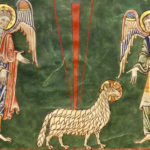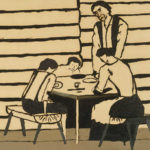We run our website the way we wished the whole internet worked: we provide high quality original content with no ads. We are funded solely by your direct support. Please consider supporting this project.
What I Am, and Am Not, Doing In These Blog Posts
In this post I’d like to try to help some potentially frustrated readers by explaining what I am, and am not, trying to accomplish in this series on the violent portraits of God in the OT. First let me explain something.
My forthcoming book, The Crucifixion of the Warrior God, fleshes out and defends a cross-centered, non-violent interpretation of the violent portraits of God in the OT. My claim is that this approach, which I label “The Cruciform Thesis,” allows us to at one and the same time see how these portrait don’t require us to accept that God ever engages in violence while disclosing how the portraits of him actually engaging in violence point to the cross, as all Scripture must do if we’re interpreting it correctly. This thesis is comprised of four principles that are developed within a cumulative case argument – that is, an argument in which the plausibility of each part is wrapped up with the plausibility of the whole, and vice versa. The thesis must thus be assessed as a whole rather than in a piecemeal way. Moreover, this cumulative case argument results in a radically different paradigm for understanding the OT’s violent divine portraits. The thesis cannot therefore be accurately assessed within the categories of the traditional paradigm for reading the OT.
I share this to explain what I am and am not doing in this series of blogs. What I am not doing is slowly unveiling The Cruciform Thesis. Indeed, I’m intentionally holding back the major components of my thesis, lest they be misjudged by being assessed in a piecemeal kind of way and within categories that are foreign to it. I’m afraid that readers looking for my proposed solution to the challenge these horrifically violent portraits posed are going to be frustrated. Following my previous blog one person said to me: “Why don’t you just tell us?!” Well I will, but only in the context of a 600+ page book defending it as a whole. This, I’m afraid, won’t be available for another 18 months or so (assuming I hit my deadline to have it sent off to IVP by July). Sorry.
Until this time, however, what I am trying to do – and I think readers who stick with these posts will find it rewarding, regardless of whether they end up agreeing with me or not – is to illustrate the sort of questions and reflections I’ve been tossing around in my head for five years, thereby pointing readers in the direction of the strange road I’ve been traveling. So, while I won’t be giving my solution to the questions I’m raising, I strongly suspect some readers who chew on these posts might end up arriving on their own at the same place, or at least within the same region, that I ended up.
You might say I’m tilling the ground and planting the seeds of my thesis that will prepare folks for the book when it (someday!) comes out. And for some folks, I’m quite sure these seeds will blossom into something similar to my thesis in their own theological greenhouses.
My next post: Why think a “ God-breathed“ book is supposed to be free of hideous portraits of God?
Neal Fowler via Compfight
Category: Essays
Tags: Bible, Crucifixion of the Warrior God, Cruciform Theology, Essay, God, Jesus, Picture of God
Topics: Interpreting Violent Pictures and Troubling Behaviors
Related Reading

Cruciform Aikido Pt 3: The Judge Who Lets Them Have It
We ended our last post noting that in the cross God ingeniously turned evil back on itself and triumphed over it. But what does all this teach us about the nature of divine judgment? Two things. First, as the one who bore our sin, Jesus experienced the judgment we deserved when the Father withdrew himself and…

What Is God’s Glory?
In John 12 we find a view of God’s glory that challenges many modern notions of what the glory of God means. In this passage, we find that Jesus was “troubled” by the cross that lay ahead to such an extent that he wanted to cry out, “Father, save me.” But Jesus quickly expresses his…

Podcast: Why Must God Wait for Prayer to Meet Our Needs?
Is God a bad father? Greg explores the intricacies and nuances of prayer. http://traffic.libsyn.com/askgregboyd/Episode_0404.mp3

Jesus is the Center of the Story
The previous post addressed how the revelation of Christ is the surprising twist that reframes how we must read all that precedes it. Today we’ll look briefly at five supports to this claim. Jesus said, “I have a testimony greater than that of John” (John 5:36). Jesus elsewhere claims that “among those born of women…

Jesus and Democracy
Question: I’ve heard that the reason Jesus didn’t speak up on political issues was because he didn’t have the benefit of living in a democracy. Since we do, don’t we have a duty both to God and our country to be involved in politics? Answer: If the reason Jesus didn’t speak up on political issues…

Podcast: How Do You Recommend Reading the Bible to Kids?
Greg looks at reading the Bible to kids and considers where in the Bible one should start reading. http://traffic.libsyn.com/askgregboyd/Episode_0311.mp3

